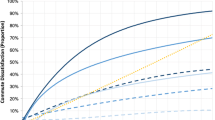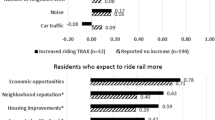Abstract
This research project took advantage of the implementation of a major mass transit improvement by New Jersey Transit which provided a "one-seat ride" into New York City for many commuters who previously had to transfer in Hoboken in order to take Port Authority Trans Hudson (PATH) trains into New York City. The creation of this new service provided a natural experiment in which some riders switched to the new route, while others continued to use their previous route. We studied psychological and psychophysiological responses to these commuting options, using a quasi-experimental, pre-post change, field research design.
We found that riders on this new line had lower levels of stress, as multiply measured, than they had earlier, before the advent of this new train, or than did other riders currently using the Hoboken-PATH option. The stress effects seemed to be mediated by the time of the trip – that is, the reduced trip time of the new, direct service seemed to be a primary factor in the reduced stress to riders. Predictability of the trip was also inversely correlated with stress, but did not distinguish between the commuter groups. These results were largely replicated with a student group who rode the same lines acting as simulated commuters.
Similar content being viewed by others
References
Averill J (1973) Personal control over aversive stimuli and its relationship to stress. Psychological Bulletin 80: 286-303.
Baron R & Kenny D (1986) The moderator-mediator variable distinction in social psychological research. Journal of Personality and Social Psychology 51: 1173-1182.
Baum A & Paulus P (1987) Crowding. In: Stokols D & Altman I (eds), Handbook of Environmental Psychology (pp 533-570). NY: Wiley.
Baum A & Grunberg N (1995) Measurement of stress hormones. In: Cohen S, Kessler RC & Gordon L (eds.), Measuring Stress (pp. 175-192). NY: Oxford University Press.
Baxter Travenol Diagnostics (1987) Gammacoat Iodine 125 Cortisol Radioimmune Assay. Cambridge, MA.
Bellet S, Roman L & Kostis J (1969) The effects of automobile driving on catecholamine and adrenocortical excretion. American Journal of Cardiology 24: 365-368.
Cohen S (1980) Aftereffects of stress on human performance and social behavior. Psychological Bulletin 88: 82-108.
Cook, TD & Campbell DT (1979) Quasi-Experimentation: Design and Analysis Issues for Field Settings. Chicago: Rand McNally.
Derogatis L (1985). Description and bibliography for the SCL-90-R. Johns Hopkins University School of Medicine. Baltimore, MD.
Eckenrode J & Gore S (1990) Stress between work and and family. NY: Plenum.
Evans GW & Carrere S (1991) Traffic congestion, perceived control, and psychophysiological stress among urban bus drivers. Journal of Applied Psychology 76: 658-663.
Evans GW (2001) Environmental stress and health. In: Baum A, Revenson T & Singer JE (eds.), Handbook Health Psychology (pp. 365-385). Hillsdale, NJ: Erlbaum.
Evans GW & Lepore SJ (1997) Moderating and mediating process in environment-behavior research. In: Moore GT & Marans RW (eds.), Advances in Environment, Behavior and Design, vol. 4 (pp. 255-285). NY: Plenum.
Frankenhaeuser M, Lundberg U, Fredrikson M, Melin B, Tuomisto M, Myrsten A, Hedman M, Bergman-Losman B & Wallin L (1989) Stress on and off the job as related to sex and occupational status in white collar workers. Journal of Organizational Behavior 10: 321-346.
Frankenhaeuser, M. (1991). The psychophysiology of sex differences as related to occupational status. In: Frankenhaeuser M, Lundberg U & Chesney M (eds.), Women, Work, and Health (pp. 39-61). NY: Plenum.
Glass DC & Singer JE (1972) Urban Stress. NY: Academic Press.
Herbert T, & Cohen S (1993) Stress and immunity in humans. Psychosomatic Medicine 55: 364-379.
Kirschbaum C & Hellhammer D (1989) Salivary cortisol in psychobiological research. Neuropsychobiology 22: 150-169.
Kluger A (1992) Commute Predictability and Strain. Paper presented at APA/NIOSH Conference on Stress in the 90s. Washington, DC.
Knox J (1961) Absenteeism and turnover in an Argentine factory. American Sociological Review 26: 424-428.
Kozlowsky M, Kluger A & Reich M (1995) Commuting Stress. NY: Plenum.
Kozlowsky M & Krausz M (1993) On the relationship between commuting, stress symptoms, and attitudinal measures: A LISREL application. Journal of Applied Behavioral Science 29: 485-492.
Krantz DS, Contrada R, Hill R & Friedler E (1988) Environmental stress and biobehavioral antecedents of coronary heart disease. Journal of Consulting and Clinical Psychology 56: 333-341.
Lepore SJ, Evans, GW & Schneider M (1992) Role of control and social support in explaining the stress of hassles and crowding. Environment and Behavior 24: 795-811.
Lundberg U (1976). Urban commuting: Crowdedness and catecholamine excretion. Journal of Human Stress 2: 26-32.
Lundberg U, de Chateau P, Winberg J & Frankenhaeuser M (1981) Catecholamine and cortisol excretion patterns in three year old children and their parents. Journal of Human Stress 7: 3-11.
Michaels, R. (1962). The effect of expressway design on driver tension responses. Public Roads 32: 107-112. New Jersey Transit (1995) Promotional flyer.
Novaco R, Kliewer W & Broquet A (1991) Home environmental consequences of commute travel impedence. American Journal of Community Psychology 19: 881-909.
Novaco R, Stokols D & Milanesi L (1990) Objective and subjective dimensions of travel impedence as determinants of commuting stress. American Journal of Community Psychology 18: 231-257.
Novaco R & Sandeen B (1992) Mitigating the stress of commuting to work: Ridesharing and the interactional effects of gender. Paper presented at APA/NIOSH, Stress in the 90s. Washington, DC.
Novaco R, Kliewer W & Broquet A (1991) Home environmental consequences of commute travel impedance. American Journal of Community Psychology 19: 881-909.
Novaco R, Stokols D & Milanesi L (1990) Objective and subjective dimensions of travel impedance as determinants of commuting stress.American Journal of Community Psychology 18: 231-257.
Novaco R, Stokols D, Campbell J & Stokols J (1979)Transportation, stress, and community psychology. American Journal of Community Psychology 7: 361-380.
Pickering T, James G, Schnall P, Schlussel Y, Pieper C, Gerin W & Karasek R (1991) Occupational stress and blood pressure: Studies in working men and women. In: Frankenhaeser M, Lundberg U & Chesney M (eds.), Women, Work and Health (pp. 171-186). NY: Plenum.
Repetti R (1989) Effects of daily workload on subsequent behavior during marital interaction. Journal of Personality and Social Psychology 57: 651-659.
Robinson A (1991) lung cancer the motor vehicle and its subtle influence on body functions. Medical Hypotheses 28: 39-43.
Sauter S, Hurrell J & Cooper CL (1989) Job Control Worker Health. NY: Wiley.
Schaeffer M, Street S, Singer J & Baum A (1988) Effects of control on the stress reactions of commuters. Journal of Applied Social Psychology 11: 944-957.
Simonson E, Baker C, Bruns N, Keiper C, Schmitt O & Stackhouse S (1968) Cardiovascular stress produced by drving an automobile. American Heart Journal 75: 125-135.
Singer JE, Lundberg U & Frankenhaeuser M (1978) Stress on the train: A study of urban commuting. In: Baum A, Singer JE & Valins S (eds.), Advances in Environmental Psychology, vol. 1 (pp. 41-56).
Stansbury K & Gunnar M (1994) Adrenocortical activity and emotion regulation. In: Fox NA (ed.).
Steptoe A & Appels A (1989) Stress, Personal Control, and Health. NY: Wiley.
Stokols D & Novaco R (1981) Transportation and well being. In: Altman I, Wohlwill JF & Everett (eds.), Transportation and Behavior (pp. 85-130). NY: Plenum.
Stokols D, Novaco R, Stokols J & Campbell J (1978) Traffic congestion, Type A behavior, and stress. Journal of Applied Psychology 63: 467-480.
Taylor P & Pocock S (1972) Commuter travel and sickness absence of London office workers. British Journal of Preventive and Social Medicine 26: 165-172.
Tri-State Transportation Campaign (1997). Midtown Direct Report Card. Mobilizing the Region, Issue 131.
Watson D & Pennebaker J (1989) Health complaints,stress, and distress: Exploring the central role of negative affectivity. Psychological Review 96: 234-254.
Watson D, Clark L & Tellegen A (1988) Development and validation of brief measures of positive and negative affect: the PANAS scales. Journal of Personality and Social Psychology 54: 1063-1070.
Wener, R., & Kaminoff, C. (1983). Improving environmental information: Effects of signs on perceived crowding and behavior. Environment and Behavior 7: 143-158.
White S and Rotton J (1998) Type of commute, behavioral aftereffects and cardiovascular activity. Environment and Behavior 30: 763-780.
Author information
Authors and Affiliations
Corresponding author
Rights and permissions
About this article
Cite this article
Wener, R.E., Evans, G.W., Phillips, D. et al. Running for the 7:45: The effects of public transit improvements on commuter stress. Transportation 30, 203–220 (2003). https://doi.org/10.1023/A:1022516221808
Issue Date:
DOI: https://doi.org/10.1023/A:1022516221808




